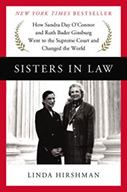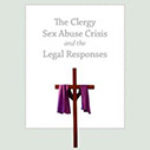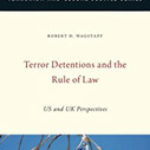Sisters in Law: How Sandra Day O’Connor and Ruth Bader Ginsburg Went to the Supreme Court and Changed the World

Author: Linda Hirshman
Publisher: New York: HarperCollins Publishers, 2015. 421p.
Reviewer: Jack E. Call | March 2016
Sisters in Law is essentially two books combined into one. Important biographical material about the book’s two protagonists includes essential information about the early years of Supreme Court Justices O’Connor and Ginsburg, without getting bogged down in unnecessary detail. The other aspect of the book is a discussion of the most important Supreme Court cases of the last fifty years dealing with sex discrimination and the role played by O’Connor and Ginsburg in those cases.
In the biographical material that deals with the lives of O’Connor and Ginsburg before they became jurists (O’Connor was appointed to the Supreme Court in 1981 and Ginsburg was appointed to the D.C. Circuit Court of Appeals in 1980), Hirshman stresses the role played by two (male) academic mentors. From Harry Rathbun, a non-practicing attorney and engineer who was the uncle of O’Connor’s dorm mate at Stanford, O’Connor learned the art of compromise – a characteristic she demonstrated throughout her judicial (and political) career. From Robert Cushman, a political scientist at Cornell, Ginsburg learned the importance of devotion to a cause (namely anti-McCarthyism). This characteristic was demonstrated throughout Ginsburg’s legal career as she directed the legal strategy of the American Civil Liberties Union’s Women’s Right Project (WRP) and expressed a consistent, well-reasoned constitutional approach in sex discrimination cases.
Hirshman also stresses the importance of the discrimination experienced by both O’Connor and Ginsburg early in their professional careers. It is fairly common knowledge that O’Connor could not find a paying job as a lawyer in California after she graduated near the top of her Stanford Law School class, an experience that clearly impacted her thinking for the rest of her professional life.
However, Ginsburg also experienced discrimination. Ginsburg had the highest grades in her third year class at Columbia (she attended Harvard Law School for two years, before transferring to Columbia after her husband, Marty, graduated from HLS and found a job in New York City) and was recommended for a clerkship by two prominent Harvard Law School professors. Nevertheless, both Justice Felix Frankfurter and renowned appellate judge Learned Hand refused to hire a female law clerk. Her initial experience with the ACLU was as a white, male-dominated institution that had little interest in pursuing a legal strategy to earn greater rights for women and resistant to extending leadership roles to women.
As a young politician in Arizona (she was the first woman to hold the office of majority leader in a state senate), O’Connor demonstrated an ability to find the middle ground (as taught by her mentor, Rathbun). She favored ratification of the Equal Rights Amendment in the early 1970’s, but when the Republican chair of the state senate judiciary committee publicly advocated a cautious, wait-and-see attitude, O’Connor quickly acquiesced.
She demonstrated this middle-of-the-road approach again in her first sex discrimination case as the first female Justice on the Supreme Court. In a case that struck down the policy of excluding men from the nursing program at the Mississippi College for Women, O’Connor’s opinion for a divided Court re-affirmed the intermediate scrutiny test in sex discrimination cases. (This was important because recent Supreme Court cases had been backing away from using this test, a more demanding one than the rational basis test used in most other discrimination cases). Nevertheless, she inserted a footnote that seemed to suggest the opinion was limited to the school of nursing at MCW (and did not apply to the college’s other programs), an apparent effort to mollify her dissenting, more conservative colleagues.
Not surprisingly, this middle-of-the-road approach could have a negative impact. For example, in Meritor Savings Bank v. Vinson (1986), the Court ruled that sexual harassment violates the Civil Rights Act, even if the behavior results in no adverse employment consequences. This was a clear victory for the feminist movement, but the Court refused to hold employers strictly liable for the sexual harassment conducted by their employees. Instead, the victim of the harassment would have to prove that the employee was acting as an agent of the employer when engaging in the acts of harassment.
A former O’Connor clerk (Stephen Gilles) and former ACLU director Aryeh Neier believe this middle-of-the-road approach may have been calculated to achieve desirable results. They contend that O’Connor was careful not to attempt more change than the Court (and society) was prepared to accept.
Hirshman characterizes this approach by O’Connor as playing defense, whereas Ginsburg “played offense.” (220) However, she played offense in a way that fit her personality. She often used concurring opinions as a way of making important suggestions about how constitutional law should change (in a way that the Court’s opinion was unwilling to do), without taking the more divisive option of dissenting. For example, one of the first cases she participated in as a new Justice, Harris v. Forklift Systems, raised the important question of how severe sexual harassment had to get to constitute a violation of the Civil Rights Act. O’Connor wrote the Court’s opinion, taking the position that the sexual harassment must be abusive before the victim can sue.
While Ginsburg did not agree with this approach (because she thought the abuse standard was too difficult for victims to satisfy), she immediately indicated that she would join the opinion. She wrote a concurring opinion that espoused an easier standard for sexual harassment victims to satisfy – whether the offensive behavior made “it harder for a reasonable person to do their job.” (217) Five years later, this strategy bore fruit when the Court adopted Ginsburg’s approach in Oncale v. Sundowner. One of her former appellate court clerks refers to opinions like Ginsburg’s concurrence in Harris as “happy face dissents,” calling for more change than the majority was willing to adopt while emphasizing as many positive aspects of the majority opinion as possible.
After O’Connor left the Court, Ginsburg’s dissents increasingly lost their “happy face.” It was not so much that she was disagreeing with the outcome, but the intensity of the disagreement that was remarkable. She began to more frequently read a summary of her dissents in court on the day the decision in a case was announced. The decision to read a dissent is significant. Ginsburg herself has indicated that reading a dissent suggests that the dissenter believes “the Court’s opinion is not just wrong, but grievously misguided.” (274)
Prior to 2006, Ginsburg had read a summary of her dissent in a case about once every other year. But she read two dissents in 2007, two in 2011, and four in 2012. All of these cases involved equal rights in one form or another, and the tone of her opinions had an edge that was missing from her dissents in previous years.
This book adds significantly to our understanding of the roles on the Court played by the first two women to serve on the Supreme Court. While it is easily read, it is not without some shortcomings – at least for academics. It is sometimes difficult to discern the date of a case being discussed from the text. In at least one instance, endnotes failed to cite an article discussed in the text. (It could be found, but not without significant effort). With regard to at least one case (Meritor Savings Bank v. Vinson), the parties’ names are reversed in a subsequent mention of the case. Not every case discussed in the book (and listed in the index) is listed in the table of cases (which includes case citations and dates). For example, Frontiero v. Richardson is not in the table, even though the book devotes considerable space to discussion of this landmark case.
In addition, some readers may object to Hirshman’s harsh criticism of Justice Kennedy in the latter portion of the book. She describes one Kennedy opinion as “particularly egregious …. ma[king] the law as hostile as possible to civil rights plaintiffs.” (285) She describes Kennedy’s “refusal to recognize the impact of social programs such as health leave on women’s equality at work” as “willful.” (283) Hirshman is very critical of the emphasis in many Kennedy opinions on women as “childbearers and caregivers,” rather than a class entitled to constitutional protection. (253)
It is clear that Hirshman considers Kennedy the most significant stumbling block on the Court to a fully robust protection of the rights of women under the Constitution. Of course, at least three or four other Justices are even more hostile to the constitutional rights of women than Kennedy, but Kennedy’s willingness to provide the fifth vote necessary to protect rights in other areas (such as protecting juveniles and the mentally impaired from capital punishment) leads perhaps to special disappointment with Kennedy’s position in many cases involving women’s rights. In addition, Kennedy has chosen (or been chosen) to write opinions in many of these cases, and has elected to make statements that many women find patronizing. The criticism that some might voice is that this book is about Justices O’Connor and Ginsburg, not about Justice Kennedy.
For students of criminal justice, this book has little to say about criminal cases in which O’Connor and Ginsburg have played important roles. There is some brief discussion of three jury cases involving the exclusion of women from jury service, either through systematic exclusion or the use of peremptory challenges. Several criminal cases are mentioned briefly to demonstrate O’Connor’s shift to the left after the Court’s decision in Bush v. Gore (a shift that Hirshman describes as a possible case of “buyer’s remorse” resulting from O’Connor’s position in that decision).
A bit more attention is given to Safford School District v. Redding, involving the strip search of a 13-year-old student by school officials. Ginsburg was so disappointed at her male colleagues’ insensitivity to what this treatment would mean to a girl of this age that she expressed her disappointment to a USA Today reporter. There is also considerable discussion about Ginsburg’s dissent in Connick v. Thompson, a case that refused to hold a district attorney liable for failure to adequately train his assistants about the constitutional law requiring prosecutors to disclose exculpatory material in their possession to the defense. The case was discussed because it resulted in Ginsburg reading her dissent in the case on decision day.
These shortcomings are quite minor. SISTERS IN LAW is essential reading for students of the Supreme Court.
Cases
Bush v. Gore, 531 U.S. 98 (2000).
Frontiero v. Richardson, 411 U.S. 677(1973).
Harris v. Forklift Systems, 510 U.S. 17 (1993).
Meritor Savings Bank v. Vinson, 477 U.S. 57 (1986).
Oncale v. Sundowner, 523 U.S. 75 (1998).
Safford School District v. Redding, 557 U.S. 364 (2009).
Jack E. Call, Professor of Criminal Justice, Radford University


